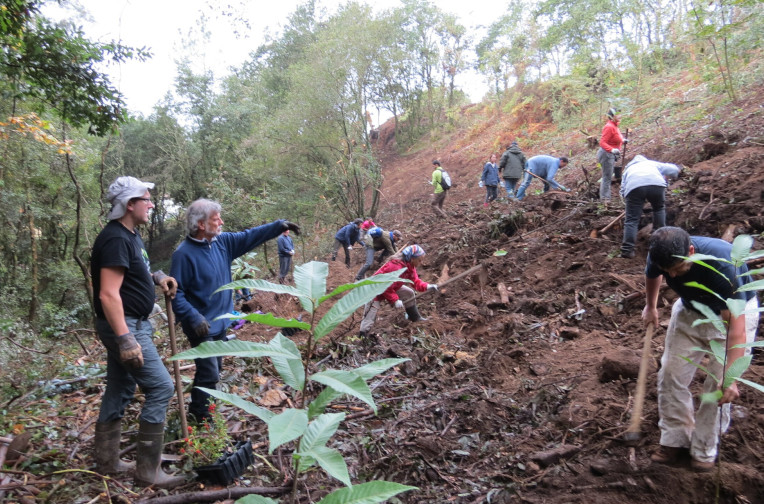This is the fourth in a series of blogs for Rapid Transition focusing on evidence-based hope from volunteer-led groups who are taking action to restore nature and tackle the climate emergency in practical ways. Thank you to Rapid Transition Alliance members and the Transition Town movement for so many inspirational stories from the UK and across their global network.
The Eucalyptus Brigades of Northern Spain
On the northern tip of the Iberian peninsular in Spain, not far from Santiago de Compostela, lies the small village of Froxán. Our story opens rather like the much-loved Asterix and Obelix comics, where “one small village of indomitable Gauls still holds out against the invaders,” but in this case, the indomitable villagers are Galicians, and the invaders are not Roman legionaries but legions of eucalyptus. It is a battle, though, and one which the villagers are determined to win.
In the years preceding and soon after the Second World War, much of the commonly owned land around this area was seized by the State. Traditional forms of communal silvo-pastoralism were severely restricted, mines began to operate and large tracts of land cleared and planted for the fast-growing and profitable eucalyptus market. Eucalyptus globulus or the Tasmanian blue gum, dominates, although acacia is also rampant. Most of the wood is destined for the vast papermills in Galicia, Asturias and northern Portugal.
To give an idea of the scale and speed of the ‘invasion’, fifty years ago, there were around 27,500 hectares of eucalyptus plantations; by 2018, this had grown to 422,000 hectares. The impact on the wildlife and rural communities has been devastating. Mixed deciduous woodlands of birch, oak, walnut, chestnut and hazel have disappeared, along with steep decline in birds, deer, wolves, foxes and badgers. Eucalyptus impoverishes the soil, contributing to greater soil erosion and run-off; it sustains very little biodiversity. It is not only ‘thirsty’ but also highly flammable: a double-whammy that has resulted in severe and widespread wildfires throughout the Iberian peninsula, most notably the fire in 2017 that burned over half a million hectares, and killed over 120 people.
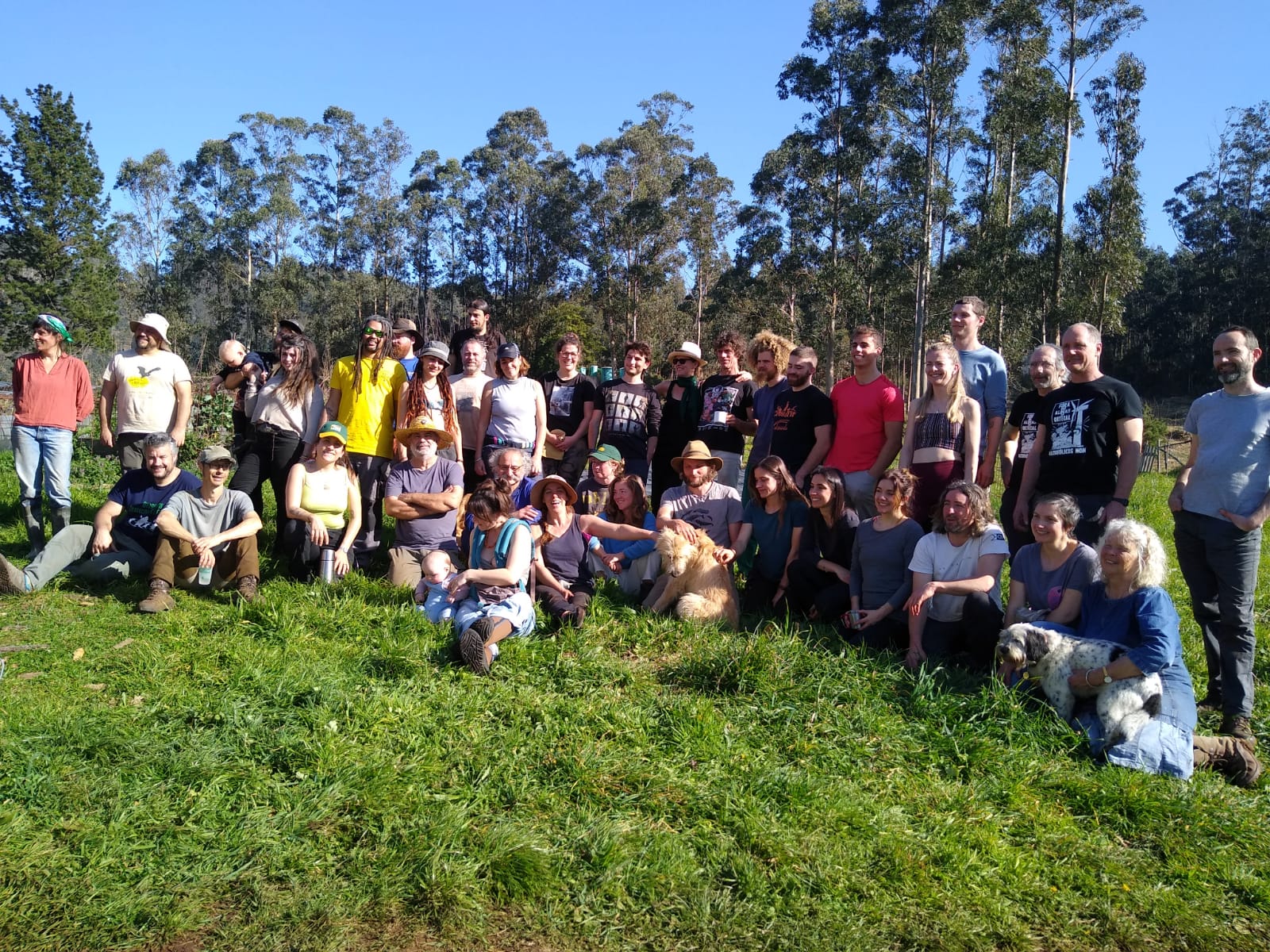
Community volunteers who clear eucalyptus and replant with native species. Photo by Fundación Montescola.
In 2002, and after decades of state management, the Froxán Commons community regained direct control over 100 hectares of land that had previously been theirs. Of course this land was not the same as the land ‘stolen’ from them in the 1940s. It was depleted, fragmented and fragile after decades of intensive monocultural forestry. In 2017, a few people in the village of Froxán decided to take matters into their own hands.
Brigadas Deseucaliptizadoras: De-eucalyptising Brigades
With 20 people in just six houses, it was an extremely small beginning. But begin they did. Working side-by-side to clear the areas around the village of eucalyptus and acacia, largely to try and protect their homes in the – increasingly likely – event of a forest fire. Froxán’s Joám Evans takes up the story. “In 2017, the community launched a nature restoration project. Hundreds of volunteers from the local area now regularly come to support us.” Collectively known as the de-eucalyptising brigades, these groups of volunteers work to fell mature trees and remove the wood from the forest, so that light can reach and begin to regenerate the leafy native plants of the understory. Armed with machetes and mattocks, they repeatedly chop down the shoots and unearth the roots to prevent regrowth. They are also actively replanting native species, helping to boost the chances for nature to recover some of its resilience. The initial brigade consisted of 30 volunteers. This has now grown to over 1300.
One of the volunteers, Xurxo, says, “the idea is to recover biodiversity, to recover the ecosystem.” In 2019, the project won the prestigious Lush Spring Prize which describes how the Brigadas “have transformed general pessimism regarding change into engaged participation” by working together.
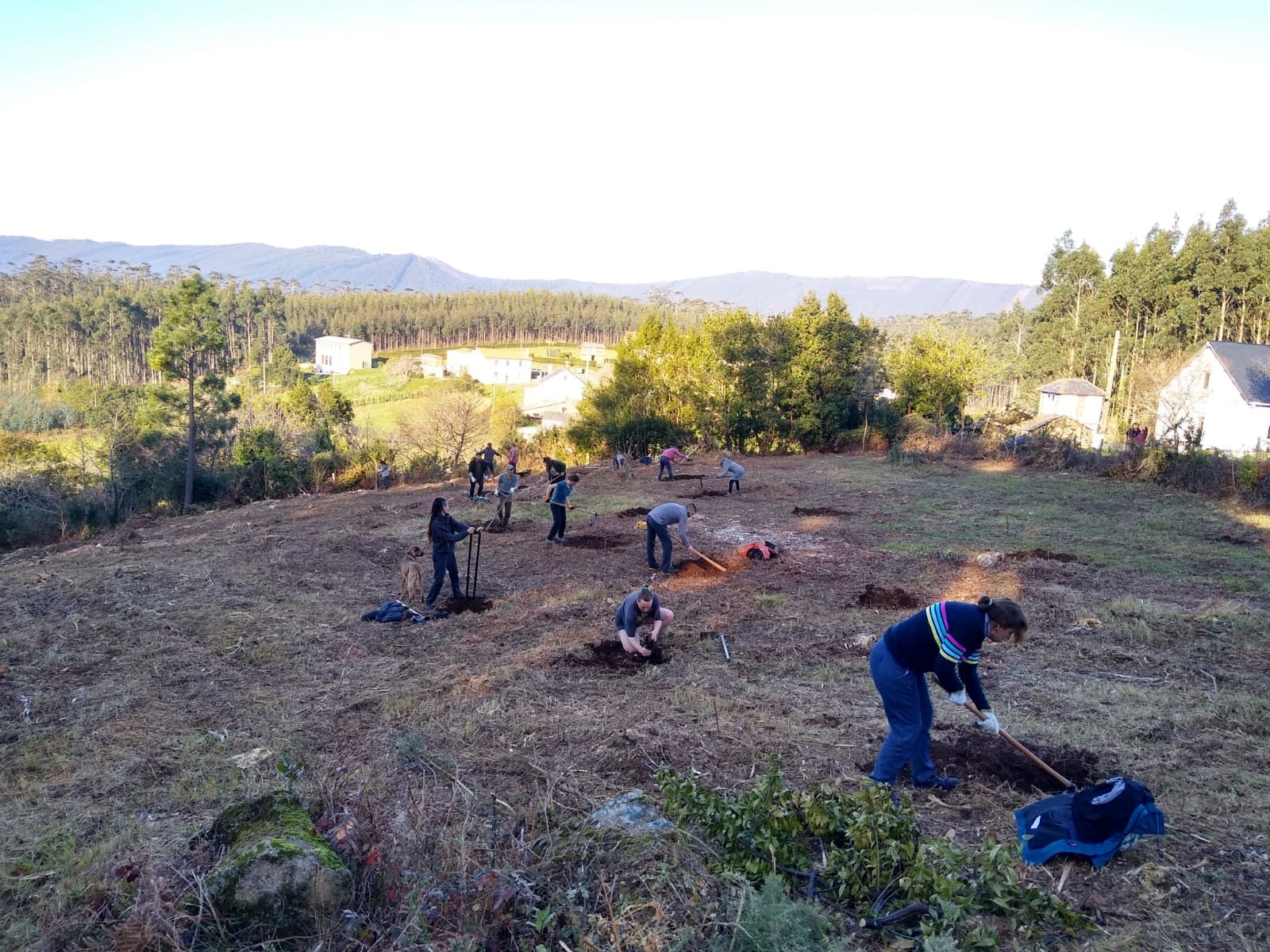
Replanting native species in cleared areas. Photo by Fundación Montescola.
“It’s incredible the change you can make. You go out with 50 people chopping down eucalyptus and planting, and see a whole hillside of new growth. You can sense the seasons again,” says Joám, “and there’s so much more biodiversity.”
It is not only woodlands that are being restored, but also – and wonderfully – an area of former peatland. Drainage ditches have been filled in, rainwater now filters down along a granite slope as it used to, replenishing springs and streams. Froxán’s freshwater drinking supply is also managed by the community.
“What unites us with many other local communities, and indigenous peoples across the planet, is that the pressures we are under are very similar. We have the pressure to give our lands to different types of extractivism, from mining, to forestry, or growing industrial crops. I believe that establishing these links with the land, can generate different forms of governance that favour conservation, that favour the restoration of nature, ultimately, generates resistance to the destruction of these areas,” he goes on.
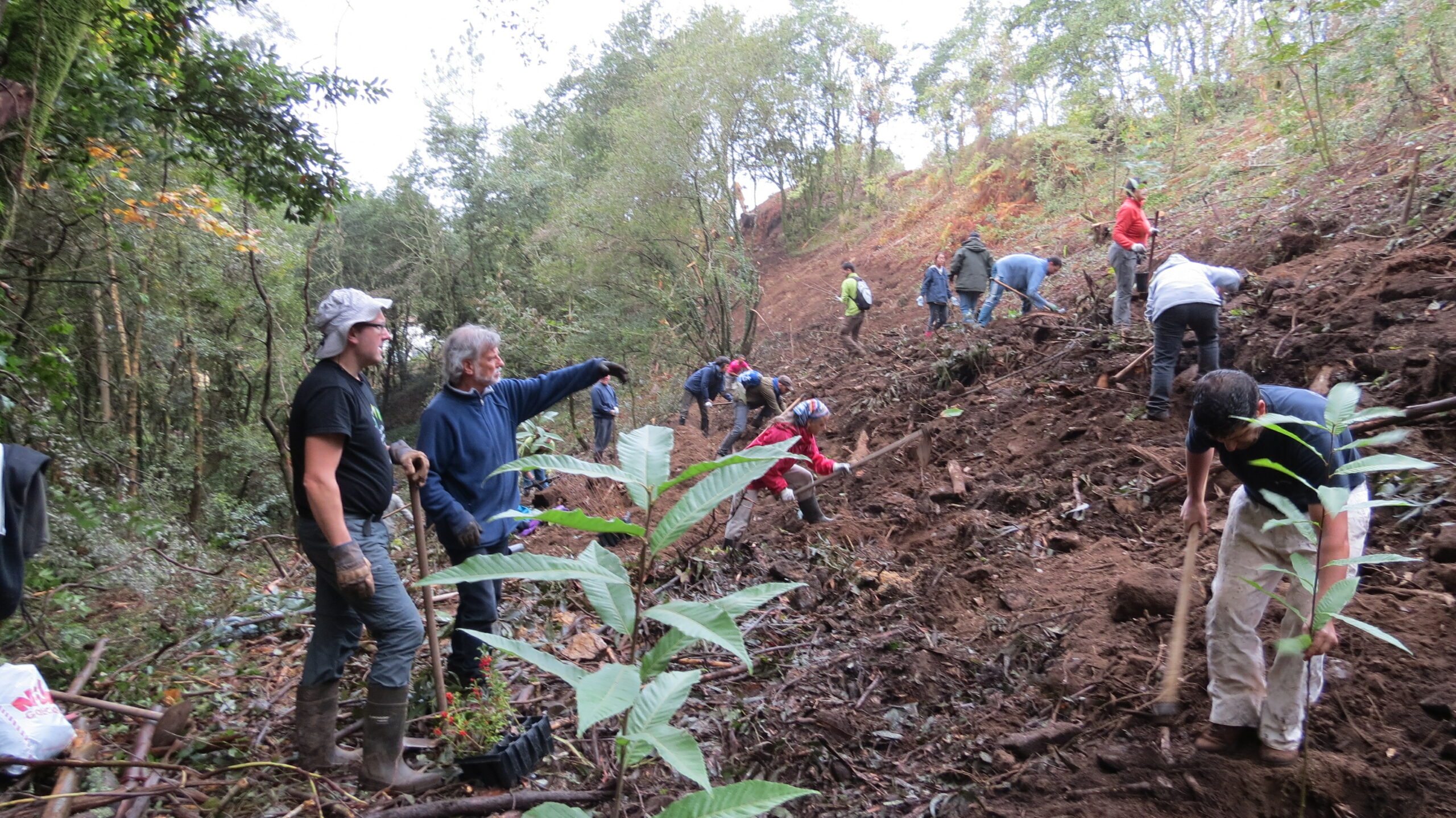
Digging out the eucalytpus plantations to make way for native plantings. Photo by Fundación Montescola.
A lot can and has been achieved from this hands-on, bottom-up civil society approach. But is that enough? Diego Cidrás of the University of Santiago de Compostela, believes that the only long-term solution to the biodiversity and socio-cultural catastrophe visited upon this region by the eucalyptus boom is by governments joining with people to effect widespread, deep and lasting change.
The Time is Right
There has never been a more urgent time for ecosystem restoration than the one we are currently in. 2021 saw the launch of the UN Decade on Ecosystem Restoration, a programme that (ambitiously) “aims to prevent, halt and reverse the degradation of ecosystems on every continent and in every ocean.” It begins with the shocking statistic that 4.7 million hectares of forests are lost every year. In 2022, it named the first ten UN World Restoration Flagships: from the restoration of the Atlantic Forest across Brazil, Argentina and Paraguay (already restored – 700,000 ha; target for 2030 – 1 million ha; target for 2050 – 15 million ha.), to the Great Green Wall for Restoration and Peace across 11 countries of the Sahel region of Africa, and the Ganges River restoration project in India.
It can be easy to lose any sense of connection – or, strangely, hope – when it comes to these mega-projects. Deep down, we know that the scale and speed of the crisis demands projects of this high-level ambition and political heft, and backed by some serious money. But there’s always the issue of accountability where it really counts: on the ground, in the land. Joám Evans sounds weary when he talks of the papermills and their loud protestations of environmental credentials: “pure greenwash” he calls it.
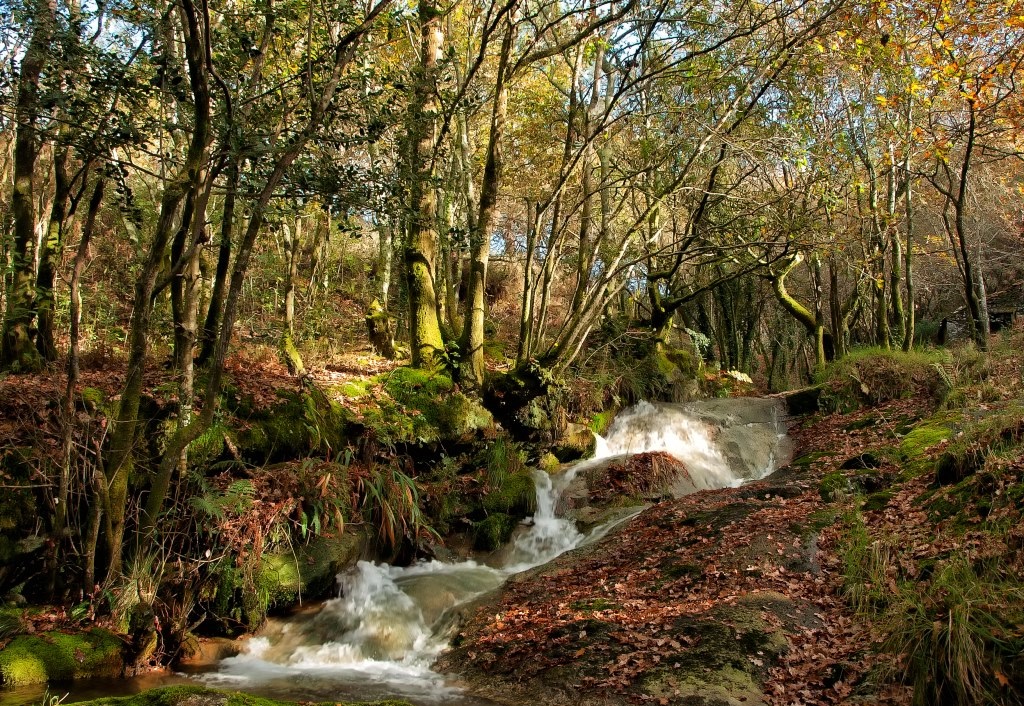
Froxan region native woodland. Photo by Fundación Montescola.
Back to the Brigadas. What is it that keeps them from going out day after day, week after week, in steadily increasing numbers for what looks like back-breakingly hard work? One of the young women in a film on the project laughs at the idea.
“It’s a day to be in contact with the countryside, with nature, as we are often rather detached from rural realities in Galicia. We come here, enjoy, contribute, become conscious… It’s a day to be together, and have a great time – it’s addictive! And that’s how we start, until one day we will end up de-eucalyptisizing Galicia with our own hands!”
Like Asterix and his indomitable friends, the fight against the invaders looks like a pushover – but we all know who wins, in the end.


